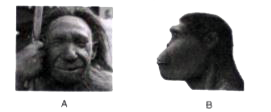A vestigial organ in human is
Ear pinna
Nictitating membrane
Mammary glands in males
Knee bone.
The correct Answer is:B
Step-by-Step Solution:
1. Understanding Vestigial Organs:
- A vestigial organ is defined as a structure that has lost most or all of its original function through the course of evolution.
2. Identifying Examples of Vestigial Organs in Humans:
- In humans, several structures are considered vestigial. Examples include:
- Auricular muscles (muscles around the ear)
- Wisdom teeth
- Vermiform appendix
- Body hair
- Nictitating membrane (a small fold in the corner of the eye)
3. Analyzing the Given Options:
- The options provided are:
- Ear
- Pinna
- Nictitating membrane
- Mammary glands in males
- Knee bone
- Among these, we need to identify which one is recognized as a vestigial organ.
4. Determining the Correct Answer:
- The nictitating membrane is a remnant of a third eyelid found in some animals, which has lost its primary function in humans. Therefore, it is classified as a vestigial organ.
5. Final Answer:
- The vestigial organ in humans is the nictitating membrane.
---
- A vestigial organ is defined as a structure that has lost most or all of its original function through the course of evolution.
- In humans, several structures are considered vestigial. Examples include:
- Auricular muscles (muscles around the ear)
- Wisdom teeth
- Vermiform appendix
- Body hair
- Nictitating membrane (a small fold in the corner of the eye)
- The options provided are:
- Ear
- Pinna
- Nictitating membrane
- Mammary glands in males
- Knee bone
- Among these, we need to identify which one is recognized as a vestigial organ.
- The nictitating membrane is a remnant of a third eyelid found in some animals, which has lost its primary function in humans. Therefore, it is classified as a vestigial organ.
- The vestigial organ in humans is the nictitating membrane.
Topper's Solved these Questions
- BOOK - DINESH PUBLICATION ENGLISHCHAPTER - EVIDENCES OF EVOLUTIONEXERCISE - CHECK YOUR GRASP19videos
EVIDENCES OF EVOLUTION
- BOOK - DINESH PUBLICATION ENGLISHCHAPTER - ENVIRONMENTAL ISSUESEXERCISE - Model test paper-5100videos
ENVIRONMENTAL ISSUES
- BOOK - DINESH PUBLICATION ENGLISHCHAPTER - EXCRETORY PRODUCTS AND THEIR ELIMINATIONEXERCISE - Check your graps10videos
EXCRETORY PRODUCTS AND THEIR ELIMINATION
Similar Questions
Knowledge Check
- Question 1 - Select One
Which is not a vestigial organ in man?
ANictitating membraneBTail vertebraeCVermiform appendixDNails
Which of the following is a vestigial organ in humans?
View SolutionWhich of the following is not vestigial organ in human beings ?
View SolutionWhich of the following is not vestigeal organ in human beings?
View SolutionWhich is not a vestigial organ in man:
View SolutionName the following:
Two vestigial organs in man.View SolutionWhich of the following is the correct group of vestigial organs in man?
View SolutionGiven below are two stages in the evolution of man. Study them and answer the questions that follow :

(i) Identify Australopithecus and Neanderthal man from the above pictures.
(ii) Mention two characteristic features each for the two stages.
(iii) Who proposed the theory of Natural Selection?
(iv) Name the organism used as an example to explain 'Industrial Melanisum'.
(v) Give two examples of Vestigial organs in humans.View Solution

